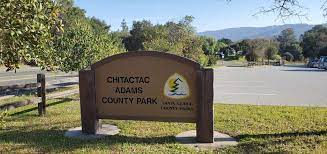Morgan Hill is built on the ancestral land of the Amah Mutsun Ohlone
By Amanda Santiago

As we chisel away the layers of time, we discover the lands, languages and beliefs of our ancestors and we learn about who we are and the world we live in.
Our town, Morgan Hill, is rich in history and began long before the railroad, ranching and agriculture arrived in the early 1800s. Its roots reach back further to a time when humans lived in partnership with the land that provided everything they needed to survive and flourish.
A meandering drive along Watsonville Road brings us to Chitactac-Adams Heritage Park, a 4.5-acre historic site on Uvas Creek. Retired military captain John Hicks Adams settled here and donated this land to become the Adams Schoolhouse from 1859 to 1956. Today, it is a park, where we can walk the shaded pathways to meet the ancestors of the Amah Mutsun tribe and visit the place they made their home.
According to the records of the Smithsonian Institute, based upon the notes of Ascension Solario, one of the last native speakers of the Mutsun language, Chitactac translates to loosely mean “The Big Dance Place.” While walking the scenic trail between these standing stones, one can also let their mind wander back in time to when families lived beside this dancing creek and prepared meals together using the mortars that are shaped into the great rocks. It is a place for both quiet contemplation and the laughter of children. It is a place to experience the living history within us all and to acknowledge how these histories flow together and continue to nourish and sustain our community.
A land acknowledgment statement is a formal statement recognizing and respecting indigenous peoples as traditional stewards of the land and appreciating the enduring relationship that exists between them and their traditional territories. Some government entities read these statements at the beginning of their meetings. They serve to protect the history and natural resources of the land we still belong to and rely upon to nourish and sustain our community. They reflect upon our ongoing need for clean water, clean air and the preservation of the open spaces where our children can continue to experience the beauty of the land we live on. It shows our gratitude to the people who came before us and cared for this land so we, too, can be sustained by it.
The benefit of these statements is in the protection, preservation and validation of our town’s unique and irreplaceable history and the natural resources of our community and places such as Chitactac, ensuring they will remain available for future generations. The benefit is in the relationships that are strengthened when we respect each other by seeing another person in their completeness. The history of me sees, acknowledges and appreciates the history of you.
When we make a land acknowledgment statement, we are recognizing that our town is built on the ancestral land of the Amah Mutsun Ohlone, and we declare our intention to uphold our responsibility to care for our town as being valuable and vital for thousands of years. We express our gratitude for this land with which we have been entrusted, and we commit to caring for our natural resources and each other.
Through this statement, we continue to strive to integrate this history into the story of our town in a lasting way and ensure it will always be available to anyone seeking strength in our shared history as we walk together into the future of our community.
Amanda Santiago is a Morgan Hill resident who serves as the chairperson of the city’s Library, Culture and Arts Commission.







